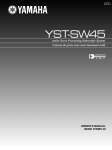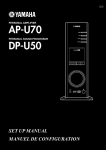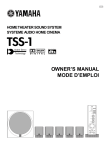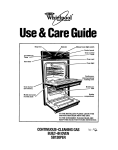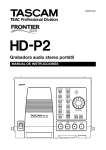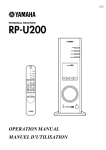Download Yamaha TSS-1 Owner`s manual
Transcript
GB HOME THEATER SOUND SYSTEM TSS-1 Active Servo Technology OWNER’S MANUAL MODE D’EMPLOI BEDIENUNGSANLEITUNG BRUKSANVISNING MANUALE DI ISTRUZIONI MANUAL DE INSTRUCCIONES GEBRUIKSAANWIJZING DIGITAL INPUT 4CH 2CH DTS MODE DIGITAL TEST PROLOGIC MUTE CENTER SURROUND SUBWOOFER MASTER VOLUME Active Servo Technology HOME THEATER SOUND SYSTEM TSS-1 MS601PRE(9/29)a 1 00.9.29, 2:33 PM 1 A B DIGITAL INPUTS OPTICAL SPEAKER OUTPUTS L FRONT COAXIAL R L SURROUND R ANALOG INPUTS 1 FRONT SURROUND 2 CENTER S. WOOFER SPEAKER MODE 5CH 4CH 2CH DIGITAL INPUT 4CH 2CH DTS MODE DIGITAL TEST PROLOGIC MUTE DC IN 15V CENTER SURROUND SUBWOOFER Amplifier unit Amplifier unit Amplifier unit Amplifier unit Amplifier unit Amplifier unit Amplifier unit MASTER VOLUME To AC receptacle Vers une prise du réceptacle CA In die Netzsteckdose Till ett eluttag Alla presa CA A la tomacorriente de CA Naar netaansluiting PA-SR601: AC adaptor Adaptateur CA Netzteil Nätadapter Trasformatore CA Adaptador de CA Netadapter Rear panel Panneau arrière Rückseite Bakpanel Pannello posteriore Panel trasero Achterpaneel Active Servo Technology HOME THEATER SOUND SYSTEM TSS-1 2 DIGITAL INPUT 4CH 2CH DTS MODE DIGITAL TEST PROLOGIC MUTE CENTER 1 2 3 4 5 DIGITAL INPUTS OPTICAL SPEAKER OUTPUTS L COAXIAL FRONT B L SURROUND ANALOG INPUTS R 6 SURROUND E R 1 FRONT SURROUND F 2 7 SUBWOOFER CENTER S. WOOFER Front panel Front panel Front panel Front panel Front panel Front panel Front panel MS601PRE(9/29)a MASTER VOLUME Active Servo Technology HOME THEATER SOUND SYSTEM TSS-1 2 8 C 9 0 A D SPEAKER MODE 5CH 4CH 2CH DC IN 15V 00.9.29, 2:33 PM Rear panel Panneau arrière Rückseite Bakpanel Pannello posteriore Panel trasero Achterpaneel English Thank you for selecting Yamaha TSS-1 Home Theater Sound System. Cautions Please read the following operating precautions before use. YAMAHA will not be held responsible for any damage and/or injury caused by not following the cautions below. ● ● ● ● ● ● ● ● ● ● ● ● ● ● ● When you disconnect the AC adaptor from the AC receptacle, hold the plug itself and not the cord. If you plan not to use this system for a while, disconnect the AC adaptor from the AC receptacle. Always disconnect the AC adaptor from the AC receptacle before making any connections. This system does not contain any user serviceable parts. Refer all servicing to your Yamaha dealer. Never open the cabinet. If a foreign object drops into the set, contact your dealer and stop using this system. Otherwise, you may cause a fire. Do not expose this system to extreme temperatures, direct sunlight, excessive dust, humidity, or vibration. Position this system on a level, stable surface. Do not drop, apply excessive force to their controls, or put heavy items on top of them. Do not place small metallic objects on this system. Otherwise, the object may fall, possibly causing an injury. Since the amplifier unit has a built-in power amplifier, heat will radiate from the ventilation slits. Place the amplifier unit apart from the walls, allowing a space of at least 20 cm (7-7/8”) above, 10 cm (3-15/16”) behind and on both sides of the amplifier unit. Also, do not position with the rear panel facing down on the floor or other surfaces and do not cover the amplifier unit with a newspaper, a tablecloth, a curtain, etc. in order not to obstruct heat radiation. If the temperature inside the amplifier unit rises, it may cause fire, damage to the amplifier unit and/or personal injury. Do not place the following objects on this system: Glass, china, etc. If glass etc. falls by vibrations and breaks, it may cause personal injury. A burning candle etc. If the candle falls by vibrations, it may cause fire and personal injury. A vessel with water in it If the vessel falls by vibrations and water spills, it may cause damage to this system, and/or you may get an electric shock. To protect this system, avoid microphone feedback, continuous and excessive output from electronic musical instruments, and excessive signal distortion. If this system is located close to a monitor, or fluorescent or neon lights, a slight hum may be heard. In this case, relocate this system away from the light. Although this system is magnetically shielded, keep floppy disks and tapes away from it. ● ● Avoid sources of hum (transformers, motors). To prevent fire or electrical shock, do not expose to rain or water. Do not use force on switches, knobs, or cables. When you move this system, first turn off the power, then disconnect the AC adaptor from the AC receptacle and the cables from the connected devices. Always set the MASTER VOLUME control fully to the left before starting to play the audio source: turn the control gradually after the play has started. Be sure to use the AC adaptor (PA-SR601) supplied with this system. Otherwise, you might cause a fire or damage to this system. Standby mode When this system is turned off by pressing the power switch, this system consumes a small amount of power. This state is called the standby mode. The power supply is completely cut off from the AC line only when the AC adaptor is disconnected. This system features a magnetically shielded design, but there is still a chance that placing it too close to a TV or a computer monitor might impair picture color. Should this happen, move this system away from the TV or the computer monitor. For U.K. customers If the socket outlets in the home are not suitable for the plug supplied with this appliance, it should be cut off and an appropriate 3 pin plug fitted. For details, refer to the instructions described below. Note: The plug severed from the mains lead must be destroyed, as a plug with bared flexible cord is hazardous if engaged in a live socket outlet. SPECIAL INSTRUCTIONS FOR U.K. MODEL IMPORTANT: THE WIRES IN MAINS LEAD ARE COLOURED IN ACCORDANCE WITH THE FOLLOWING CODE: Blue: NEUTRAL Brown: LIVE As the colours of the wires in the mains lead of this apparatus may not correspond with the coloured markings identifying the terminals in your plug, proceed as follows: The wire which is coloured BLUE must be connected to the terminal which is marked with the letter N or coloured BLACK. The wire which is coloured BROWN must be connected to the terminal which is marked with the letter L or coloured RED. Making sure that neither core is connected to the earth terminal of the three pin plug. E-1 SR601ENG(9/29)e 1 00.9.29, 2:34 PM Contents Cautions .......................................................... 1 Controls & connectors ................................. 6 Unpacking ...................................................... 2 Adjusting speaker balance ........................... 8 Features ......................................................... 2 Playing a source ............................................ 8 Setting up the speakers ................................ 4 Troubleshooting ............................................ 9 Connections .................................................. 6 Specifications .............................................. 10 Unpacking Features After unpacking, check that the following parts are contained. ● Amplifier unit ● Satellite speaker x 5 ● ● Satellite speaker with a 3 m cord x 3 Satellite speaker with a 7 m cord x 2 ● Subwoofer ● Accessories ● ● ● ● ● ● ● Mini plug cable x 2 Optical fiber cable x 1 Coaxial cable x 1 Stand for the amplifier unit x 1 Screw x 2 Pad x 16 Fastener x 1 Multi-Channel Surround System for Home Theater, Game Amusement and PC DVD. ● Combination of Amplifier Unit, Five Satellite Speakers and Subwoofer ● Dolby Digital and DTS decoder ● 5.1-Channel Full-Scale System for DVD Movie Entertainment ● 5.1-Ch Full-Scale, 4.1-Ch (Game Surround) and Stereo (Virtual Surround) Speaker Modes ● Yamaha’s Exclusive Active Servo Technology for Powerfull Bass Response ● 1 Optical and 1 Coaxial Digital Input Terminals ● Two Analog Input Terminals (front/rear channel) ● Test Tone Generator for Accurate Speaker Settings (Refer to the next page.) E-2 SR601ENG(9/29)e 2 00.9.29, 2:34 PM English Welcome to the exciting world of digital home entertainment. The TSS-1 is a compact, but complete and advanced home theater sound system that takes you to the exciting world of digital surround sound entertainment. Though some of the advanced features of this system may not be familiar to you, they are easy to use. Incorporated state-of-art technology such as Dolby Digital and DTS can bring the same audio experience to your home as they have brought to feature films in quality theaters around the world. Take some time now to read more about these features and enjoy the new experiences this system brings to your home theater. ■ Dolby Surround Dolby Surround uses four discrete channels and five speakers to reproduce realistic and dynamic sound effects: two main channels (left and right), a center channel for dialog, and a rear channel for special sound effects. The rear channel reproduces sound within a narrow frequency range. Most video tapes and laser discs include Dolby Surround encoding, as do many TV and cable broadcasts. The Dolby Pro Logic decoder built into this unit employs a digital signal processing system that stabilizes each channel for even more accurate sound positioning than is available with standard analog processors. ■ Dolby Digital * Dolby Digital is a digital surround sound system that provides completely independent multi-channel audio to you. Dolby Digital provides five full-range channels in what is sometimes referred to as a “3/2” configuration: three front channels (left, center and right), and two surround channels. A sixth bass-only effect channel is also provided for output of LFE (low frequency effect), or low bass effects that are independent of other channels. (This is called the “LFE channel”.) This channel is counted as 0.1, thus giving rise to the term 5.1 channels in total. The wide dynamic range of sound reproduced by the five full-range channels and precise sound orientation by digital sound processing provides listeners with excitement and realism that have never been experienced before. ■ DTS (Digital Theater System) Digital Surround ** DTS was developed to replace the analog soundtracks of movies with six discrete channels of digital soundtracks, and it is now installed in many theaters around the world. The DTS digital playback system changed the way we experienced movies in theaters with six discrete channels of superb digital audio. DTS technology, through intense research and development has made it possible to deliver similar encode/decode discrete technology to home audio surround-sound entertainment. DTS Digital Surround is an encode/decode system which delivers six channels of master-quality, 20-bit audio; technically, it is 5.1 channels, which means 5 full-range (left, center, right and two surround) channels, plus a subwoofer (LFE) channel (as “0.1”). It is compatible with the 5.1 speaker configurations that are currently available for home theater systems. Notes ● When playing an ordinary CD on this system following playback of a CD or an LD encoded with DTS, some operations, such as resetting input modes, may be required. ● Even if connected to this system with a digital connection, some CD, LD, and DVD players may make this system fail to decode DTS or produce noise. This is because certain digital output data processing by such a player results in DTSencoded data errors that cause playback failure although the same data processing may cause only a slight change in volume or in frequency response in normal digital sound. ● When an error occurs in the player’s digital output data during playback of an LD or CD encoded with DTS, playback may be disrupted. If this occurs, stop playback and repower the player. ● When digital sound signals from the computer are played, errors in WAVE signals, etc. may occur resulting in noise or a playback failure. * Manufactured under license from Dolby Laboratories. “Dolby”, “Pro Logic” and the double-D symbol are trademarks of Dolby Laboratories. Confidential Unpublished Works. q1992–1997 Dolby Laboratories, Inc. All rights reserved. ** Manufactured under license from Digital Theater Systems, Inc. US Pat. No. 5,451,942 and other worldwide patents issued and pending. “DTS”, “DTS Digital Surround”, are trademarks of Digital Theater Systems, Inc. Copyright 1996 Digital Theater Systems, Inc. All Rights Reserved. E-3 SR601ENG(9/29)e 3 00.9.29, 2:34 PM Setting up the system System configuration Recommended speaker placement This system includes an amplifier unit, five satellite speakers and a subwoofer. The three satellite speakers with a 3 m cord are used for front speakers and a center speaker. The two satellite speakers with a 7 m cord are used for surround speakers. Before making connections, place all speakers in their respective positions. The positioning of the speakers is important because it controls the whole sound quality of this system. Place the speakers depending on your listening position by following the instructions below. * The satellite speakers can be mounted on a wall. The roll of respective speakers The front speakers are used for outputting main channel sound. The surround speakers are used for effect sounds, and the center speaker is for center channel sound (dialog etc.). The subwoofer is used for outputting sounds of low frequencies from the front, center and surround channels. The subwoofer also outputs sounds of the subwoofer channel when a source is played with DTS or Dolby Digital decoded. Front speakers: On both sides of and at approximately the same height as the TV (or computer monitor). Surround speakers: Behind your listening position or on both sides of the listening room. Center speaker: Precisely between the front speakers. * Though the center speaker can be mounted on the monitor as shown on the next page, it is not so recommended for safety. Subwoofer: On the foor. The position of the subwoofer is not so critical because low bass tones are not highly directional. It is recommended to place the subwoofer obliquely facing the wall. Now making an illustration E-4 SR601ENG(9/29)e 4 00.9.29, 2:34 PM m Mounting a center speaker on top of the monitor The front angle of the satellite speakers can be adjusted as shown below. When placing the center speaker on top of the monitor, remove the stand from the speaker, and put the provided fastener at the bottom of the speaker and on top of the monitor to prevent the speaker from falling. * Do not mount the speaker on top of the monitor with an inclination to a level surface of more than 10 degrees. 1 Loosen the screw on the bottom of the speaker stand. * Put the supplied nonskid pads at the four corners on the bottom of the stand to obtain more stability. Now making an illustration Pads 2 English m Adjusting the front angle of the satellite speakers Slide the speaker on the stand as you prefer, and then tighten the screw. Note m Mounting satellite speakers on a wall The satellite speakers can also be hung on the wall. Fasten screws into a firm wall or wall support as shown in the figure, and hang the slits on the rear of the speaker on the protruding screws. * Make sure that the screws are securely caught by the slits. Tapping screw (4 mm) (Available at the hardware store) 4 mm Though this speaker is a magnetically shielded type, there may be some influence on a monitor picture depending on the type of monitor or the placement of the speaker. In such a case, place the speaker apart from the monitor so that there is no influence on the monitor picture. m Mounting the amplifier unit on the supplied stand To obtain stability, it is recommended to mount the amplifier unit to the supplied stand with the supplied screws as shown below. * Put the supplied nonskid pads at the four corners on the bottom of the stand to obtain more stability. Min. 20 mm Wall/ wall support 50 mm Pads Warning ● Each speaker weighs 0.4 kg (0.9 lbs.). Do not mount them on thin plywood or a wall with soft surface material. If mounted, the screws may come out of the flimsy surface and the speakers may fall. This damages the speakers or causes personal injury. ● Do not install the speakers to a wall with nails, adhesives, or any other unstable hardware. Long-term use and vibrations may cause them to fall. ● To avoid accidents resulting from tripping over loose speaker cords, fix them to the wall. SR601ENG(9/29)e 5 E-5 00.9.29, 2:34 PM Connections (See figure 1 on inside of the front cover.) Caution: Plug in the amplifier unit and other equipment after all connections are completed. A : Connect three satellite speakers with a 3 m cord to the FRONT L, R and CENTER terminals. Connect two satellite speakers with a 7 m cord to the SURROUND L and R terminals. Connect the subwoofer to the SUBWOOFER terminal. B : Connect external audio/video units (a personal computer, a video game player, a portable DVD/CD player, a video cassette player, etc. which send playback signals to this system) to these terminals. Cautions ● When placing the provided AC adapter on the desk, etc., be sure to fix the adapter on the desk, etc. to prevent it from falling. If the adapter falls, it may cause personal injury or damage to the adapter and/or other equipment. ● The SPEAKER OUTPUT terminals on the rear of the amplifier unit are special for connecting with the supplied speakers. Never connect these terminals to an AV amplifier or a power amplifier, otherwise it may cause not only a misoperation of this system, but also damage to this system. Controls & connectors (See figure 2 on inside of the front cover.) 1 INPUT selector button and indicators PROLOGIC: Select this mode to reproduce an input source with Dolby Prologic decoded. This mode can be selected only when input signal is encoded with Dolby Prologic. This mode cannot be selected when the input mode is set to 4CH. Press this button repeatedly to select an input mode between DIGITAL, 4CH and 2CH. The current mode is shown by the lighting of the corresponding indicator. DIGITAL: Select this mode to reproduce signals received at the OPTICAL or the COAXIAL terminal on the rear panel. When both OPTICAL and COAXIAL terminals receive signals, the signals at the OPTICAL ternminal are selected. 4CH: Select this mode to reproduce signals received at the FRONT and SURROUND terminals on the rear panel in a 4 channel surround sound mode. (The center speaker is not used in this mode.) * If a signal encoded with DTS or Dolby Digital is inputted with no surround mode selected, the corresponding indicator lights up dimly. 3 Press this button to output a test tone from the speakers. A test tone is outputted from the front, center, surround and subwoofer in turn. The test tone is used for adjusting volume balance among all the speakers. * Not all of the speakers output the test tone depending on the setting of the SPEAKER MODE switch (C). 2CH: Select this mode to reproduce signals received at the FRONT terminals on the rear panel in a 2-channel stereo mode. 2 MODE selector button and indicators TEST key 4 MUTE button and indicator Press this button to cut off sound output temporarily. When this function is active, the indicator lights up. Press this button again to restore sound output. * Sound output will also be restored by changing the status of this system between standby and power-on modes, and changing the input mode or the surround mode. Press this button repeatedly to select the desired surround mode between DTS, DIGITAL, PROLOGIC and off. The current mode is shown by the lighting of the corresponding indicator. When no mode is selected, no indicator lights up. DTS: Select this mode to reproduce an input source with DTS decoded. This mode can be selected only when the input signal is encoded with DTS and the input mode is set to DIGITAL. 5 DIGITAL: Select this mode to reproduce an input source with Dolby Digital decoded. This mode can be selected only when the input signal is encoded with Dolby Digital and the input mode is set to DIGITAL. 6 CENTER level control This control is used for adjusting the level of sound outputted from the center speaker. Turn this control clockwise to increase the level, and counterclockwise to decrease the level. SURROUND level control This control is used for adjusting the level of sound outputted from the surround speakers. Turn this control clockwise to increase the level, and counterclockwise to decrease the level. E-6 SR601ENG(9/29)e 6 00.9.29, 2:34 PM SUBWOOFER level control This control is used for adjusting the level of sound outputted from the subwoofer. Turn this control clockwise to increase the level, and counterclockwise to decrease the level. 8 D E MASTER VOLUME control OPTICAL: Connect an external unit (a DVD/CD player, an MD recorder, a video game player, etc.) which has an optical digital signal output terminal to this terminal by using the supplied optical cable. Headphone jack Power indicator Lights up when the power of this system is on. A Power switch Each press of this switch changes the status of this system between standby mode and power on. When the power is on, the power indicator (0) lights up. * Note that this system uses a small amount of power in the standby mode. B SPEAKER OUTPUTS FRONT: Connect one satellite speaker with a 3 m cord to the L terminal and another to the R terminal. They are used as the front speakers. SURROUND: Connect one satellite speaker with a 7 m cord to the L terminal and the other to the R terminal. They are used as the surround speakers. DIGITAL INPUTS External units which has digital signal output terminals can be connected to these terminals. Input signals received at the OPTICAL terminal have priority over the signals at the COAXIAL terminal. When both terminals receive signals, the signals at the OPTICAL terminal are reproduced with this system. Stereo headphones can be connected to this mini-jack for private listening. Sound output from the speakers are cut off when headphones are connected to this jack. Sounds of all channels are mixed into 2-channels and outputted from the headphones. 0 DC IN connector Connect the supplied AC adaptor to this connector. This control is used for adjusting the whole volume level of this system. Turn this control clockwise to increase the level, and counterclockwise to decrease the level. 9 English 7 COAXIAL: Connect an external unit (a DVD/CD player, an MD recorder, a video game player, etc.) which has an coaxial digital signal output terminal to this terminal by using the supplied coaxial cable. F ANALOG INPUTS Connect analog signal output terminals of an external unit to these mini-jack terminals by using the supplied mini plug cables or commercially available pin-to-mini plug cables. FRONT: Connect an analog (stereo) signal output terminal of an external unit to this terminal by using a supplied mini plug cable. When you connect a sound board on a computer which has four channel output terminals, connect the front channel output terminal of the sound board to this terminal. SURROUND: When you connect a sound board on a computer which has four channel output terminals, connect the rear channel output terminal of the sound board to this terminal. CENTER: Connect one satellite speaker with a 3 m cord to this terminal. It is used as the center speaker. C SPEAKER MODE switch Normally, set this switch to 5CH. According to your preference, set this switch to another position. 5CH: All speakers are used in this mode. 4CH: Select this position when you will not use the center speaker. In this mode, center sound is outputted from the front L and R speakers. 2CH: Select this position when you wish to output sounds in 2-channels only. In this mode, sounds of all channels are mixed and outputted from the front L and R speakers. The surround speakers output the same sounds as the front speakers. E-7 SR601ENG(9/29)e 7 00.9.29, 2:34 PM Adjusting speaker balance This procedure lets you adjust the sound output level balance between the front, center, surround speakers and the subwoofer by using the built-in test tone generator. Make this adjustment so that each speaker output level becomes almost the same when heard at the listening position. This is important for high performance of the builtin DTS decoder and Dolby Digital decoder. * Once you have completed this adjustment, you can adjust the overall volume level of this system only by using the MASTER VOLUME control. Playing a source This section explains how to turn on this system and select input sources. Before turning on this system, turn on the external audio unit to be used. DIGITAL 3 6 INPUT 4CH 2CH DTS MODE DIGITAL TEST PROLOGIC MUTE CENTER DIGITAL INPUT SURROUND DIGITAL INPUTS OPTICAL 4CH 2CH DTS SPEAKER OUTPUTS MODE DIGITAL L TEST PROLOGIC MUTE 5, 8 FRONT SUBWOOFER COAXIAL R 1, 5 L CENTER SURROUND R 1 4, 7 SURROUND ANALOG INPUTS FRONT MASTER VOLUME SURROUND Active Servo 2 Technology HOME THEATER SOUND SYSTEM TSS-1 CENTER SUBWOOFER 2, 6 1 SPEAKER MODE 5CH 4CH 2CH MASTER VOLUME DC IN 15V Active Servo Technology HOME THEATER SOUND SYSTEM TSS-1 2 S. WOOFER 1 Turn the MASTER VOLUME control fully counterclockwise to decrease the volume to minimum. 2 Turn on this system. 3 Select the appropriate input mode by pressing the INPUT selector button. 3 1 Set the SPEAKER MODE switch to “5CH” if it is set to another position. 2 Turn the MASTER VOLUME control fully counterclockwise to decrease the volume to minimum. * The indicator for the selected input mode lights up. * Refer to the “Controls & connectors” on page 4 for details about the input modes. 3 Turn on this system. 4 Play s source on the external unit. 4 Set the CENTER, SURROUND and SUBWOOFER level controls at the center position. 5 Adjust the volume to the desired level. 6 As you prefer, select a surround mode. CENTER SUBWOOFER SURROUND * Refer to the “Controls & connectors” on page 4 for details about the surround modes. 5 Press the TEST button. 6 Adjust the master volume to the desired level. * You will hear a test tone (like pink noise) from respective speakers for about two seconds in the following order: front speakers, center speaker, surround speakers and subwoofer . 7 Adjust the CENTER, SURROUND and SUBWOOFER level controls while listening a series of test tones so that their levels become almost the same with the front speakers’ level. 8 When the adjustment is completed, press the TEST button. * The test tone stops . E-8 SR601ENG(9/29)e 8 00.9.29, 2:34 PM Refer to the chart below when the speakers do not function properly. If the problem you are experiencing is not listed below or if the instructions given below do not help, disconnect the AC adaptor and contact your authorized YAMAHA dealer or service center. Cause Problem What to Do The AC adaptor is not properly plugged into the AC receptacle. Insert the AC adaptor firmly into the AC receptacle. The power of this system is set to off. Turn on the power by pressing the power switch. (The power indicator lights up.) Connections are faulty or incomplete. Make the connections again. Appropriate input mode is not selected. Select the appropriate input mode by pressing the INPUT selector button. The volume setting is low. Turn the MASTER VOLUME control clockwise to increase the volume. The MUTE function is active. (The indicator on the left side of the MUTE button is illuminated.) Press the MUTE button to cancel this function. (Some other operations also cancel this function.) The SURROUND level control is set to minimum. Turn the SURROUND level control clockwise to increase the level. No surround mode is selected. Select the appropriate surround mode by pressing the MODE button. If no mode can be selected, change the input source to another which is encoded with DTS, Dolby Digital or Dolby Prologic. The CENTER level control is set to minimum. Turn the CENTER level control clockwise to increase the level. The SPEAKER MODE switch on the rear panel of the amplifier unit is set to “2CH” or “4CH”. Set the SPEAKER MODE switch to “5CH”. No surround mode is selected. Select the appropriate surround mode by pressing the MODE button. If no mode can be selected, change the input source to another which is encoded with DTS, Dolby Digital or Dolby Prologic. No sound from the center and surround speakers though the DTS or DIGITAL mode indicator is illuminated. Dim illumination of an indicator means that signals encoded with the corresponding format (DTS or Dolby Digital) is inputted to this system. In this case, the signals are mixed into 2-channels and outputted from the front speakers only. Press the MODE button for the appropriate surround format. The indicator turns bright, and the center and surround speakers output sounds since the surround format is decoded. The DIGITAL mode indicator is dimly illuminated and the PROLOGIC mode indicator is brightly illuminated. The input source encoded with Dolby Digital may be originally in 2-channel mode. Check the setting of the digital output on the player which is sending input signals to this system. If the input source is originally in 2channel mode, use the PROLOGIC mode to enjoy the source in a multi-channel mode. Sound is distorted. The level of the signal being inputted is too low. Turn up the volume on the connected component. Noise. The level of the signal being inputted is too high. Turn down the volume on the connected component. Connections are faulty or incomplete. Make the connections again. The amplifier unit is near the monitor. Place the amplifier away from the monitor. No sound comes from the speakers or subwoofer. No sound from the surround speakers No sound from the center speaker English Troubleshooting E-9 SR601ENG(9/29)e 9 00.9.29, 2:34 PM Specifications Control unit Satellite speaker Minimum RMS Output Power per Channel ........................ 20W + 20W (20 Hz–20 kHz, 6Ω, 0.4% THD) Type ............... 2-way 2-speaker bass-reflex speaker system Magnetically shielded type Maximum Power .......... 26W + 26W (1 kHz, 6Ω, 10% THD) Input Sensitivity/Input Impedance PC IN, AUX1 IN, AUX2 IN (ANALOG) ........ 150 mV/35 kΩ Driver Woofer ........................................ 9 cm (3-9/16”) cone type Tweeter ........................... 2.5 cm (1”) balanced dome type Maximum Input Signal PC, AUX1, AUX2 .............................. 2.1V or more (1 kHz) Nominal Input Power .................................................. 40W Output Level/Output Impedance REC OUT ................................................... 150 mV/2.0 kΩ SUBWOOFER OUTPUT .................... 2.0V/1.7 kΩ (50 Hz) Headphone Jack Output Level/Output Impedance ANALOG PC IN, etc. .......... 320 mV/61Ω (1 kHz, 150 mV) Frequency Response USB, DIGITAL IN (PC, AUX1) to SP Output .................................................... 20 Hz–20 kHz (51.0 dB) Total Harmonic Distortion (1 kHz, 20 kLPF) USB, DIGITAL IN (PC, AUX1) to SP Output ........................................................ 0.06% or less (4V/6Ω) Signal to Noise Ratio USB to SP Output ...................... 85 dB or more (11V/6Ω) PC IN, AUX1 IN (DIGITAL) to SP Output ..................................................... 90 dB or more (11V/6Ω) Residual Noise (IHF-A Network) ......................................... –68 dB or less (SP Output, L/R) Power Supply [U.S.A. and Canada models] .................. AC 120V, 60 Hz [Europe and U.K. models] ...................... AC 230V, 50 Hz [Australia model] .................................... AC 240V, 50 Hz Power Consumption [U.S.A. and Canada models] .................................... 60W [Europe, U.K. and Australia models] ....................... 55W Dimensions (W 2 H 2 D) .............. 120 2 294 2 355 mm (4-3/4” 2 11-9/16” 2 14”) Weight ................................................. 5.5 kg (12 lbs. 2 oz.) Maximum Input Power .............................................. 100W Impedance ...................................................................... 6Ω Frequency Response ................................. 75 Hz – 33 kHz Sensitivity .................................................... 88 dB/2.83V/m Crossover Frequency ................................................ 7 kHz Dimensions (W x H x D) ....... 107 mm x 191 mm x 141 mm (4-3/16” x 7-1/2” x 5-9/16”) Weight .............................................. 1.5 kg (3 lbs. 5 oz.) x 4 Subwoofer Type ................ Active Servo Processing Subwoofer System Driver ............................... 20 cm (8”) cone woofer (JA2162) Magnetically shielded type Amplifier Output ..................................................... 70W/5Ω High-Cut Filter ...................... 50 Hz – 150 Hz (–24 dB/oct.) Frequency Response .................. 30 Hz – 200 Hz (–10 dB) Dimensions (W x H x D) ....... 235 mm x 365 mm x 318 mm (9-5/16” x 14-7/20” x 12-1/2”) Weight .................................................. 9 kg (19 lbs. 13 oz.) Accessories Mini plug cable x 2 Optical fiber cable x 1 Coaxial cable x 1 Stand for the amplifier unit x 1 Screw x 2 Pad x 16 * Please note that all specifications are subject to change without notice. E-10 SR601ENG(9/29)e 10 00.9.29, 2:34 PM












